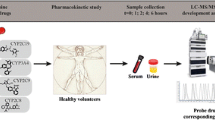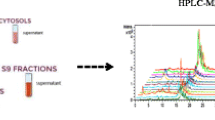Abstract
Anaprazole, a new proton pump inhibitor (PPI), is designed for the treatment of acid-related diseases, such as gastric ulcers and gastroesophageal reflux. This study explored the in vitro metabolic transformation of anaprazole. The metabolic stabilities of anaprazole in human plasma and human liver microsomes (HLM) were analyzed by liquid chromatography-tandem mass spectrometry (LC–MS/MS). Then, the contribution (%) of non-enzymatic and cytochrome P450s (CYPs) enzyme-mediated anaprazole metabolism was assessed. To obtain the metabolic pathways of anaprazole, the metabolites generated in HLM, thermal deactivated HLM, and cDNA-expressed recombinant CYPs incubation systems were identified by ultra-performance liquid chromatography/quadrupole-time-of-flight mass spectrometry (UPLC/Q-TOF–MS). Results showed that anaprazole was very stable in human plasma and unstable in HLM. The contribution (%) of non-enzymatic vs. CYPs enzyme-mediated metabolism was 49% vs. 51%. CYP3A4 was the major enzyme (48.3%), followed by CYP2C9 (17.7%) and CYP2C8 (12.3%), in responsible for the metabolism of anaprazole. Specific chemical inhibitors targeting CYP enzymes notably blocked the metabolic transformation of anaprazole. Six metabolites of anaprazole were identified in the non-enzymatic system, whereas 17 metabolites were generated in HLM. The biotransformation reactions mainly included sulfoxide reduction to thioether, sulfoxide oxidation to sulfone, deoxidation, dehydrogenation, O-dealkylation or O-demethylation of thioether, O-demethylation and dehydrogenation of thioether, O-dealkylation and dehydrogenation of thioether, thioether O-dealkylation and dehydrogenation of thioether, and O-dealkylation of sulfone. Both enzymatic and non-enzymatic metabolisms contribute to the clearance of anaprazole in human. Anaprazole is less likely to develop drug-drug interactions in clinical use compared to other PPIs.




Similar content being viewed by others
Data availability
The datasets used or analyzed during the current study are available from the corresponding author on reasonable request.
References
Bertilsson L (1995) Geographical/interracial differences in polymorphic drug oxidation Current state of knowledge of cytochromes P450 (CYP) 2D6 and 2C19. Clin Pharmacokinet 29(3):192–209
Blume H et al (2006) Pharmacokinetic drug interaction profiles of proton pump inhibitors. Drug Saf 29(9):769–784
Chaudhry AS, Kochhar R, Kohli KK (2008) Genetic polymorphism of CYP2C19 & therapeutic response to proton pump inhibitors. Indian J Med Res 127(6):521–530
Chawla PK et al (2015) Correlation of CYP2C19 genotype with plasma voriconazole levels: a preliminary retrospective study in Indians. Int J Clin Pharm 37(5):925–930
Cheng DX et al (2016) Determination of anaprazole in human plasma by LC-MS/MS in pharmacokinetic study. Yao Xue Xue Bao 51(12):1885–1890
Croom EL, Wallace AD, Hodgson E (2010) Human variation in CYP-specific chlorpyrifos metabolism. Toxicology 276(3):184–191
Davies B, Morris T (1993) Physiological parameters in laboratory animals and humans. Pharm Res 10(7):1093–1095
De Morais SM et al (1994) Identification of a new genetic defect responsible for the polymorphism of (S)-mephenytoin metabolism in Japanese. Mol Pharmacol 46(4):594–598
Denisenko NP et al (2018) CYP3A and CYP2C19 activity in urine in relation to CYP3A4, CYP3A5, and CYP2C19 polymorphisms in Russian peptic ulcer patients taking omeprazole. Pharmgenomics Pers Med 11:107–112
El Rouby N, Lima JJ, Johnson JA (2018) Proton pump inhibitors: from CYP2C19 pharmacogenetics to precision medicine. Expert Opin Drug Metab Toxicol 14(4):447–460
Fock KM et al (2008) Proton pump inhibitors. Clin Pharmacokinet 47(1):1–6
Gao W et al (2021) Different dose of new generation proton pump inhibitors for the treatment of Helicobacter pylori infection: a meta-analysis. Int J Immunopathol Pharmacol 35:20587384211030396
Gyawali CP (2017) Proton pump inhibitors in gastroesophageal reflux disease: friend or foe. Curr Gastroenterol Rep 19(9):46
Harris DM et al (2021) Use of pharmacogenomics to guide proton pump inhibitor therapy in clinical practice. Dig Dis Sci 66(12):4120–4127
Ishizaki T, Horai Y (1999) Review article: cytochrome P450 and the metabolism of proton pump inhibitors–emphasis on rabeprazole. Aliment Pharmacol Ther 13(Suppl 3):27–36
Klotz U, Schwab M, Treiber G (2004) CYP2C19 polymorphism and proton pump inhibitors. Basic Clin Pharmacol Toxicol 95(1):2–8
Li XQ et al (2004) Comparison of inhibitory effects of the proton pump-inhibiting drugs omeprazole, esomeprazole, lansoprazole, pantoprazole, and rabeprazole on human cytochrome P450 activities. Drug Metab Dispos 32(8):821–827
Lima JJ et al (2021) Clinical pharmacogenetics implementation consortium (CPIC) guideline for CYP2C19 and proton pump inhibitor dosing. Clin Pharmacol Ther 109(6):1417–1423
McColl KE, Kennerley P (2002) Proton pump inhibitors–differences emerge in hepatic metabolism. Dig Liver Dis 34(7):461–467
Mori H, Suzuki H (2019) Role of acid suppression in acid-related diseases: proton pump inhibitor and potassium-competitive acid blocker. J Neurogastroenterol Motil 25(1):6–14
Neumann I, et al (2013) Comparison of different regimens of proton pump inhibitors for acute peptic ulcer bleeding. Cochrane Database Syst Rev (6):CD007999
Ogawa R, Echizen H (2010) Drug-drug interaction profiles of proton pump inhibitors. Clin Pharmacokinet 49(8):509–533
Pallotta S, Pace F, Marelli S (2008) Rabeprazole: a second-generation proton pump inhibitor in the treatment of acid-related disease. Expert Rev Gastroenterol Hepatol 2(4):509–522
Ray WA et al (2018) Association of oral anticoagulants and proton pump inhibitor cotherapy with hospitalization for upper gastrointestinal tract bleeding. JAMA 320(21):2221–2230
Riu-Viladoms G et al (2019) Drug interactions with oral antineoplastic drugs: the role of the pharmacist. Eur J Cancer Care (engl) 28(1):e12944
Rodrigues AD (1999) Integrated cytochrome P450 reaction phenotyping attempting to bridge the gap between cDAN-expressed cytochromes P450 and native human liver microsome. Biochem Pharmacol 57:465–480. https://doi.org/10.1016/s0006-2952(98)00268-8
Sakaguchi M et al (2012) Comparison of PPIs and H2-receptor antagonists plus prokinetics for dysmotility-like dyspepsia. World J Gastroenterol 18(13):1517–1524
Shi S, Klotz U (2008) Proton pump inhibitors: an update of their clinical use and pharmacokinetics. Eur J Clin Pharmacol 64(10):935–951
Strand DS, Kim D, Peura DA (2017) 25 years of proton pump inhibitors: a comprehensive review. Gut Liver 11(1):27–37
Tang C et al (2020) Qualitative and quantitative determination of anaprazole and its major metabolites in human plasma. J Pharm Biomed Anal 183:113146
Tytgat GN (2001) Shortcomings of the first-generation proton pump inhibitors. Eur J Gastroenterol Hepatol 13(Suppl 1):S29-33
Vaezi MF, Yang YX, Howden CW (2017) Complications of proton pump inhibitor therapy. Gastroenterology 153(1):35–48
Wedemeyer RS, Blume H (2014) Pharmacokinetic drug interaction profiles of proton pump inhibitors: an update. Drug Saf 37(4):201–211
Zhu HPX, Zhang L, Sun H, Fan H, Pan Z, Huang C, Shi Z, Ding J, Wang Q, Du Y, Lyu N, Li Z (2022) Effect and safety of anaprazole in the treatment of duodenal ulcers: a randomized, rabeprazole-controlled, phase III non-inferiority study. Chin Med J (Engl) 12(24)
Author information
Authors and Affiliations
Contributions
Conceptualization: Fei Liu, Yanjun Xu, and Xiaomei Zhuang; methodology and data analysis: Fei Liu, Li Wang, Zhen Zhang, and Xifeng Ma; writing—original draft preparation: Fei Liu; writing—review and editing: Xiaomei Zhuang. All authors have read and agreed to the published version of the manuscript. The authors confirm that all data were generated in-house and that no paper mill was used.
Corresponding author
Ethics declarations
Competing interests
The authors declare no competing interests.
Ethical approval
No applicable.
Conflict of interest
The authors declare no competing interests.
Additional information
Publisher's note
Springer Nature remains neutral with regard to jurisdictional claims in published maps and institutional affiliations.
Supplementary information
Below is the link to the electronic supplementary material.
Rights and permissions
Springer Nature or its licensor (e.g. a society or other partner) holds exclusive rights to this article under a publishing agreement with the author(s) or other rightsholder(s); author self-archiving of the accepted manuscript version of this article is solely governed by the terms of such publishing agreement and applicable law.
About this article
Cite this article
Liu, F., Xu, Y., Wang, L. et al. Combined contributions of cytochrome P450s (CYPs) and non-enzymatic metabolism in the in vitro biotransformation of anaprazole, a novel proton pump inhibitor. Naunyn-Schmiedeberg's Arch Pharmacol 396, 1759–1771 (2023). https://doi.org/10.1007/s00210-023-02415-7
Received:
Accepted:
Published:
Issue Date:
DOI: https://doi.org/10.1007/s00210-023-02415-7




